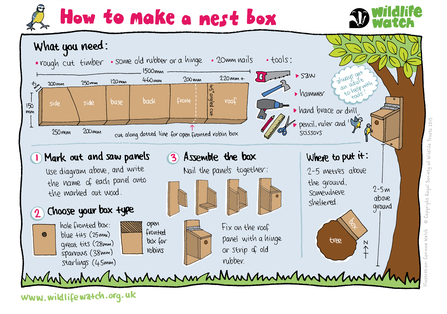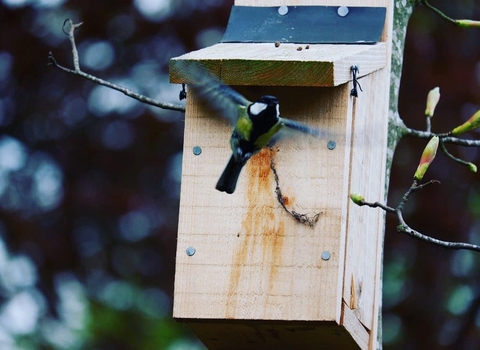As our environments have changed, birds and bats have suffered from a lack of suitable natural breeding sites, so the addition of a nesting or roost box can be a welcome refuge.
Bird boxes
Gardens that are well designed are easily capable of supporting families of blue tits, robins and blackbirds. However it is more difficult to get birds to breed than to feed in your garden. This is partly because the chosen nesting site needs to be in a territory that will provide most of the food that both the adults and young need during this busy phase.
Build your own
Below is a simple closed box design to attract tits, sparrows and nuthatches. By altering the diameter of the entrance hole you can attract different bird species:
27mm - Blue, coal and marsh tits
28mm - Tree sparrow
29mm - House sparrow
30mm - Great tits
32mm - Nuthatch, pied flycatcher
You will need:
- Rough cut, unplaned, untreated, softwood timber, 15 cm wide x 150 cm long x 1.5 cm thick
- Scrap rubber, such as an old inner tube from a tyre
- Galvanised 20 mm (3/4") nails
- Saw
- Hammer
- Drill
- Pencil and ruler
- Scissors
Bird nest box building instructions
Lucy's nest box building video (https://youtu.be/qXPjMsqOgTg)
Watch Lucy Shepherd build a nest box for National Nest Box Week!

Location, Location, Location
Birds are also quite specific in their nest requirements. If you are thinking of putting up a bird box, position is crucial. Make sure your nest box is in a sheltered position, facing north-east to south-east, to avoid prevailing wet winds and the heat of the midday sun.
The nest box should also be about 2m off the ground and away from overhanging branches to stop cats reaching the nest. Boxes can be hung from wires to discourage predators, but you must use four wires to ensure that the box will not spin.
Come springtime garden birds start the frantic search for materials to build and insulate the perfect nest. You can give them a hand by putting out suitable nesting materials. Try hanging bundles of straw, fine sticks, shredded woollen jumpers and bunches of grasses close to your feeding station. Your bundles should last through to the summer season of second broods.
Please plot your nest box location on our interactive map:
Click below for information on swift conservation and nest boxes:
Make your garden even wilder - take a look at our wildlife gardening pages:
Maintenance
After the end of each breeding season, all nestboxes should be taken down, old nesting materials removed, and the box should be scalded with boiling water to kill any parasites. It is important to leave it for a few weeks until the young have fledged as they may roost in the box for a while after they have left the nest. Do not use insecticides or flea-powders – boiling water is adequate. Annual cleaning is best carried out from late September to February.
Under the terms of the Wildlife and Countryside Act 1981, if unhatched eggs are found in the box, they can only legally be removed from October to January inclusive, and they must be destroyed – it is illegal to keep them.

